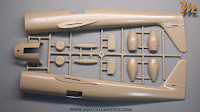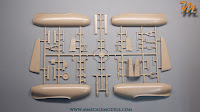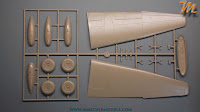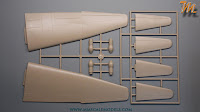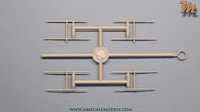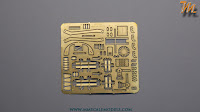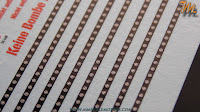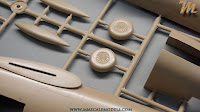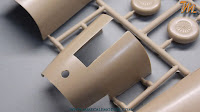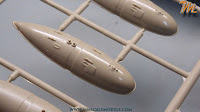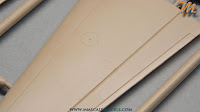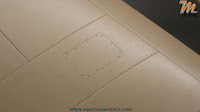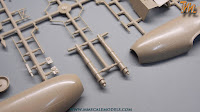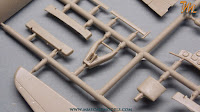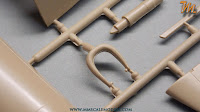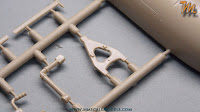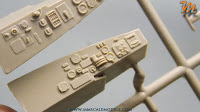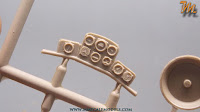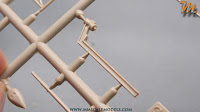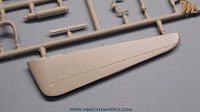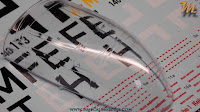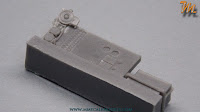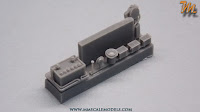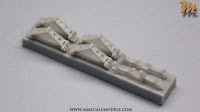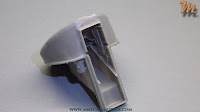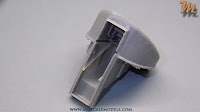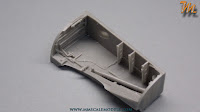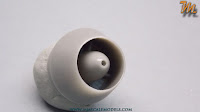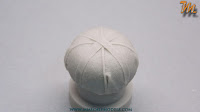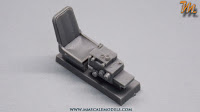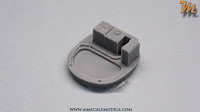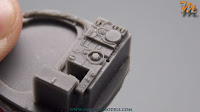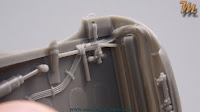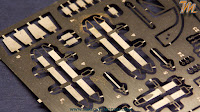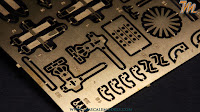Arado Ar 234 B-2N
1/32 Fly models - plastic scale model inbox review
This mixed media scale model kit of the legendary Arado 234 nightfighter came out in 2014 in addition to the bomber version. Packed with resin its a "big bite" even for the experienced modeler. What is inside that big box... lets check that out.
Arado Ar 234 - History
The Arado Ar 234 Blitz (German: lightning) was the world's first operational jet-powered bomber, built by the German Arado company in the closing stages of World War II.
Produced in very limited numbers, it was used almost entirely in the reconnaissance role, but in its few uses as a bomber it proved to be nearly impossible to intercept. It was the last Luftwaffe aircraft to fly over Britain during the war, in April 1945.
In late 1940, the Reich Air Ministry (German: Reichsluftfahrtministerium, abbreviated RLM) offered a tender for a jet-powered high-speed reconnaissance aircraft with a range of 2,156 km (1,340 mi). Arado was the only company to respond, offering their E.370 project, led by Professor Walter Blume. This was a high-wing conventional-looking design with a Junkers Jumo 004 engine under each wing.
Arado estimated a maximum speed of 780 km/h (480 mph) at 6,000 m (20,000 ft), an operating altitude of 11,000 m (36,000 ft) and a range of 1,995 km (1,240 mi). The range was short of the RLM request, but they liked the design and ordered two prototypes as the Ar 234. These were largely complete before the end of 1941, but the Jumo 004 engines were not ready, and would not be ready until February 1943. When they did arrive they were considered unreliable by Junkers for in-flight use and were cleared for static and taxi tests only. Flight-qualified engines were finally delivered, and the Ar 234 V1 made its first flight on 30 July 1943 at Rheine Airfield (presently Rheine-Bentlage Air Base).
Arado Ar 234 B-2N
It was intended to modify upwards of 30 Ar 234B-2 airframes for the night-fighting role, from a proposal dated 12 September 1944 between Arado director Walter Blume and Goering's top aviation technologist, Siegfried Knemeyer. Designated Ar 234B-2/N and code named Nachtigall (Nightingale), these aircraft were fitted with FuG 218 "Neptun" VHF-band radar, with the appropriately reduced-length eight-dipole element version of the standard Hirschgeweih transceiving AI radar antenna system, and carried a pair of forward-firing MG 151/20 autocannon within a Magirusbombe conformal gun pod on the ventral fuselage hardpoint. A second crew member, who operated the radar systems, was accommodated in a very cramped compartment in the rear fuselage. Two of these jury-rigged night fighters served with Kommando Bonow, an experimental test unit attached to Luftflotte Reich. Operations commenced with the pair of 234s in March 1945, but Bonow's team soon found the aircraft to be unsuited for night fighting and no kills were recorded during the unit's very brief life.
In late 1940, the Reich Air Ministry (German: Reichsluftfahrtministerium, abbreviated RLM) offered a tender for a jet-powered high-speed reconnaissance aircraft with a range of 2,156 km (1,340 mi). Arado was the only company to respond, offering their E.370 project, led by Professor Walter Blume. This was a high-wing conventional-looking design with a Junkers Jumo 004 engine under each wing.
Arado estimated a maximum speed of 780 km/h (480 mph) at 6,000 m (20,000 ft), an operating altitude of 11,000 m (36,000 ft) and a range of 1,995 km (1,240 mi). The range was short of the RLM request, but they liked the design and ordered two prototypes as the Ar 234. These were largely complete before the end of 1941, but the Jumo 004 engines were not ready, and would not be ready until February 1943. When they did arrive they were considered unreliable by Junkers for in-flight use and were cleared for static and taxi tests only. Flight-qualified engines were finally delivered, and the Ar 234 V1 made its first flight on 30 July 1943 at Rheine Airfield (presently Rheine-Bentlage Air Base).
Arado Ar 234 B-2N
It was intended to modify upwards of 30 Ar 234B-2 airframes for the night-fighting role, from a proposal dated 12 September 1944 between Arado director Walter Blume and Goering's top aviation technologist, Siegfried Knemeyer. Designated Ar 234B-2/N and code named Nachtigall (Nightingale), these aircraft were fitted with FuG 218 "Neptun" VHF-band radar, with the appropriately reduced-length eight-dipole element version of the standard Hirschgeweih transceiving AI radar antenna system, and carried a pair of forward-firing MG 151/20 autocannon within a Magirusbombe conformal gun pod on the ventral fuselage hardpoint. A second crew member, who operated the radar systems, was accommodated in a very cramped compartment in the rear fuselage. Two of these jury-rigged night fighters served with Kommando Bonow, an experimental test unit attached to Luftflotte Reich. Operations commenced with the pair of 234s in March 1945, but Bonow's team soon found the aircraft to be unsuited for night fighting and no kills were recorded during the unit's very brief life.
source: wikipedia
Arado Ar 234 B-2N - The kit
Arado Ar 234 B-2N - box contents
The 1/32 scale Arado Ar 234 B-2N from FLY models (kit number 32008) comes in big , top opening box with a Arado Ar 234 on a bomb run over some city as a boxart. Inside the box there are five beige injection molded plastic sprues, one clear plastic sprue, 21 blocks with resin parts, one photo etched fret, two types of thread, one metal rod, one decal sheet, one full color sheet with camouflage schemes and instructions.
Arado Ar 234 B-2N - instructions
The instructions come in A5 size book. They start with the parts breakdown and numbering. There are no part numbers on the sprues so that is something the modeler will refer to quite often. The total number of assembly steps is 66 but there are more than one sub-assembly on each step. The construction starts from the cockpit as with many other scale models. The assembly is quite complicated but at this first glance the instructions seem to be clear and relatively easy to follow. On step 35 there is instruction to put weight on the bulkhead behind the cockpit, unfortunately the exact weight is not written.
Arado Ar 234 B-2N - decals and camouflage schemes
The decals carrier film seems to be sufficiently thin. Colors are rich and the printing in register. The set of instrument faces is very good. For the canopy framing there are black decals with screw heads printed on them. Text is readable but slightly out of register on some places. The camouflage schemes for the Arado Ar 234 are printed in four view layout on one A4 sheet. What is strange is that although stating the same RLM 81, 82 and 76 the colors of the print on the both sides of the sheet are very different.
The marking options are as follows:
1. Arado Ar 234 B-2N, W.Nr. 140146/SM+FF Flown by Oblt. Bonow and operator Ofw. Marchetti, Kommando Bonow, Oranienburg 1945
2. Arado Ar 234 B-2N, W.Nr. 140145/SM+FE Flown by Hptm. Bisping and operator Hptm. Vogel, Kommando Bonow, Oranienburg 1945
3. Arado Ar 234 B-2N, W.Nr. 140344/T9+EH Flown by Oblt. Erich K. Sommer, Campoformido Air Base (Udine), Italy, April 1945
4. Arado Ar 234 B-2, W.Nr. 140173/F1+MT, 9./KG 76 Flown by Hptm. Josef Regler, March 1945
The marking options are as follows:
1. Arado Ar 234 B-2N, W.Nr. 140146/SM+FF Flown by Oblt. Bonow and operator Ofw. Marchetti, Kommando Bonow, Oranienburg 1945
2. Arado Ar 234 B-2N, W.Nr. 140145/SM+FE Flown by Hptm. Bisping and operator Hptm. Vogel, Kommando Bonow, Oranienburg 1945
3. Arado Ar 234 B-2N, W.Nr. 140344/T9+EH Flown by Oblt. Erich K. Sommer, Campoformido Air Base (Udine), Italy, April 1945
4. Arado Ar 234 B-2, W.Nr. 140173/F1+MT, 9./KG 76 Flown by Hptm. Josef Regler, March 1945
Arado Ar 234 B-2N - on the plastic sprues
Sprue A
On sprue A there are the two fuselage halves, the section below the cockpit, the front wheel, the rocket engines halves, the main gear well doors and the external fuel tanks adapters. The plastic is typical for Fly models but unlike their later models in this scale there are not many surface details. The panel lines are sharp and consistent but a little bit shallow, perhaps some deepening will be necessary.
On the inside of the fuselage halves there is nothing except some very subtle location aid for the resin wheel wells. Speaking of them, if you want to be able to see more of their elaborate detail you'll have to cut the front door of the gear bay.
For the nightfighter version the opening for the operator will have to be cut out as well as two holes to accommodate additional blisters (again for the operator cockpit). The surface details on the JATO rocket pods is quite good.
Flash is evident here and there but that is to be expected. The front wheel is a bit simple and lacks weighted appearance.
On the inside of the fuselage halves there is nothing except some very subtle location aid for the resin wheel wells. Speaking of them, if you want to be able to see more of their elaborate detail you'll have to cut the front door of the gear bay.
For the nightfighter version the opening for the operator will have to be cut out as well as two holes to accommodate additional blisters (again for the operator cockpit). The surface details on the JATO rocket pods is quite good.
Flash is evident here and there but that is to be expected. The front wheel is a bit simple and lacks weighted appearance.
Sprue B
On sprue B there are the lower halve wings, the external fuel tanks, the main wheels, a few air scoops for the engine nacelles, the center line mounting point for the cannon or for bombs, some misc items.
The surface detail on the wings lower halves is just as on the fuselage halves - nice panel lines, may be a bit shallow, some riveting detail on the access panels and along a couple of panel lines.
The details on the wheels are quite nice but there is no weighting here as well.
The fuel tanks and the mounting point are also detailed quite well, but details are on the soft side.
The surface detail on the wings lower halves is just as on the fuselage halves - nice panel lines, may be a bit shallow, some riveting detail on the access panels and along a couple of panel lines.
The details on the wheels are quite nice but there is no weighting here as well.
The fuel tanks and the mounting point are also detailed quite well, but details are on the soft side.
Sprue C
Sprue C contains the upper parts of the wings, the horizontal stabilizers and the center pieces of the engine exhausts.Sprue D
On sprue D there are quite a lot of parts compared with the previous sprues. Here are the engine nacelles, the front and rear gear legs, Instrument panel and side consoles for the cockpit as well as a bunch of other interior pieces, the rudder and some misc. bits and pieces.
The engine nacelles are no different than the wings and fuselage when it comes to surface detail.
The main gear legs are very sturdy looking pieces with nice detail on them. They will need some brake lines.
The nose gear leg is quite complex, its assembly instruction extends on 5 steps with many parts involved. Great care should be taken to fit properly otherwise it may ruin the look of the finished scale model.
The instrument panel and side consoles are very impressive. The instrument faces have raised details and are molded crisply in most places. There are some particles molded om the surfaces that must be removed.
Unfortunately these small parts exhibit at most the "nature of the beast" (limited run kit) and need thorough clean up.
The nose gear leg is quite complex, its assembly instruction extends on 5 steps with many parts involved. Great care should be taken to fit properly otherwise it may ruin the look of the finished scale model.
The instrument panel and side consoles are very impressive. The instrument faces have raised details and are molded crisply in most places. There are some particles molded om the surfaces that must be removed.
Unfortunately these small parts exhibit at most the "nature of the beast" (limited run kit) and need thorough clean up.
Sprue E
Sprue E is a small one and it only carries the dipole antennae and the antennae loop. The rods of the dipole look thin and straight but will need a clean up, which is a bit of an issue. I personally will use hypodermic needles instead.Clear Parts Sprue
The Arado Ar 234 have very distinctive front end and it is all transparent allowing all the cockpit detail to be visible. So you can imagine how important the clear parts are. There are 11 clear parts including some wingtip lights and small circular windows in addition to the main canopy parts. The cockpit access door is not open so if you want it in opened position get some saws :)
The canopy parts appear to be with good clarity and no distortion on the flat-ish parts. Distortion on the curved areas is to be expected. When you get things close its fine ( the back of the instrument panel should be very clearly visible in the nose section).
Annoyingly though, if you try to look a bit further it gets ugly. What is more there is some kind of wavy texture embedded in both inner and outer surfaces accompanied with some pinholes. I will try to remedy those issues with sanding and polishing but results are unclear.
Very clever approach is the distance left between the actual transparent panels and the joint with the rest of the fuselage. This way blending the two together should be much less risky business.
Arado Ar 234 B-2N - resin parts
Well we came to the most interesting and impressive part of this Arado Ar 234 kit - the resin parts. And they a lot and some of them are big some are small but all are simply stunning. On the instructions there are 40 resin positions but many of them represent multiple (identical) parts so they are more than 50.So what comes in resin? Here: the cockpit bulkhead and rear cockpit structure which houses the front gear bay; the operator cockpit; the main gear bays; the pilot and operator seats; details for the gear legs, the parachutes for the JATO rocket pods, the intake and exhaust parts of the engines; the cannon pod and muzzles; many small parts - antennae, cockpit parts etc.
I haven't been digging in reference materials yet so I am not aware of how accurate these parts are. All I know right now is that they look sublime.
Arado Ar 234 B-2N - photo etched parts
To further detail up this scale model the modeler have some photo etched parts at his disposal. On the fret there are seatbelts, rudder pedals some structural elements and various levers, handles and hinges.Arado Ar 234 B-2N - misc parts
There are two types of twine that come with the kit, one is for the JATO chutes and the other is for the brake chute. Also there is a metal rod which looks like some sort of antennae mast on the left wing underside.
Arado Ar 234 B-2N - aftermarket
Arado Ar 234 B-2N - conclusion
It is difficult and sometimes deceptive to evaluate a scale model kit without actually building it. But when it comes to limited run kits with lots of resin and photoetch parts, lack of part location aid and the necessity to clean up all plastic parts it is quite clear that it will be a hard build with a lot of labor, skills and experience in demand. So when buying such a kit the modeler should be aware that he or she is going on another level where real masterpieces are born and in the same time great disappointment and loss of time and money lurks behind every corner.
When you "bite the bullet" and accept the above, the 1/32 scale Arado Ar 234 B-2N is a beautiful scale model kit with massive amount of detail already in the box and if you fancy some scratch building there is so much more that can be done in this scale.
Every kit has its low spots, here the clear parts need attention. They are just not on par with the plastic, resin and PE parts that are going underneath them.
This kit would greatly benefit from an engine. Since there is no engine included one possible source can be the 1/32 scale Me-262 from Trumpeter. Also the lack of weighted appearance on the tires is unacceptable especially in this scale.
Finally I will say that I absolutely love this kit and cant wait to get some books and start building it.
Best regards and happy modelling
Metodi Metodiev
When you "bite the bullet" and accept the above, the 1/32 scale Arado Ar 234 B-2N is a beautiful scale model kit with massive amount of detail already in the box and if you fancy some scratch building there is so much more that can be done in this scale.
Every kit has its low spots, here the clear parts need attention. They are just not on par with the plastic, resin and PE parts that are going underneath them.
This kit would greatly benefit from an engine. Since there is no engine included one possible source can be the 1/32 scale Me-262 from Trumpeter. Also the lack of weighted appearance on the tires is unacceptable especially in this scale.
Finally I will say that I absolutely love this kit and cant wait to get some books and start building it.
Best regards and happy modelling
Metodi Metodiev



